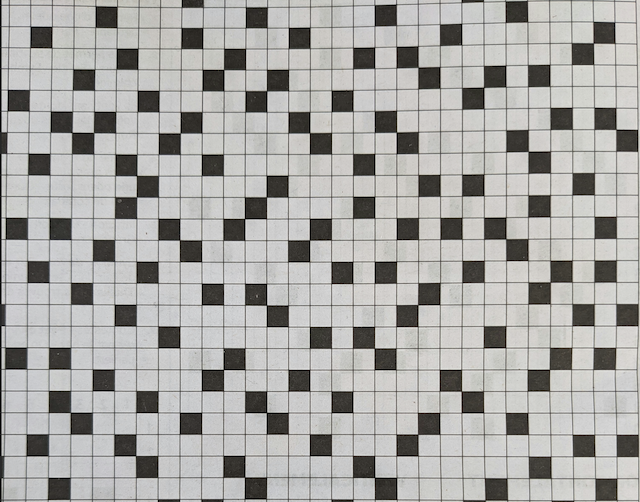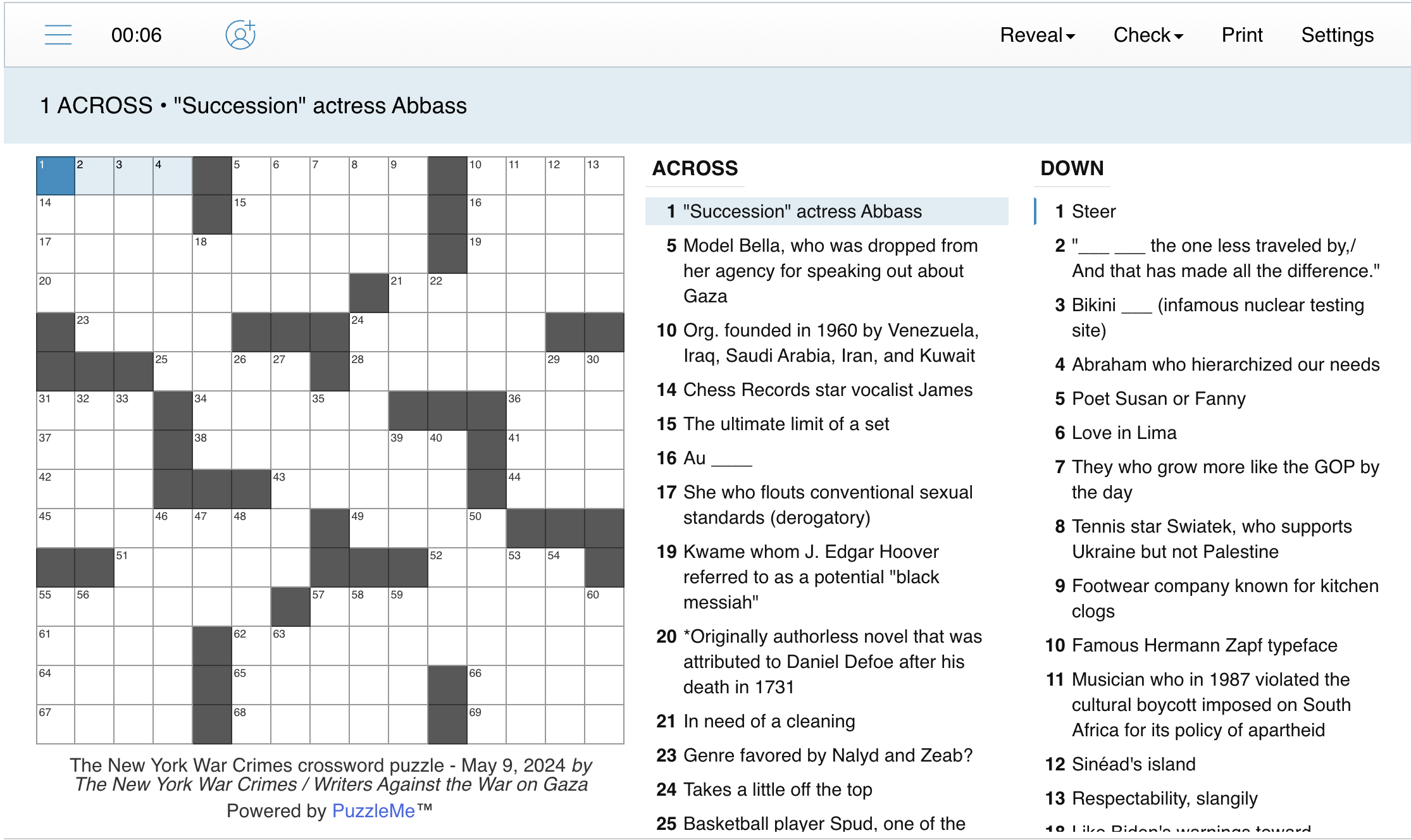The Puzzle That Wants to Destroy The New York Times

When over 100 members of Writers Against the War on Gaza occupied the lobby of the New York Times building back in March, the actionists distributed a variety of flyers, in addition to copies of its newspaper, The New York War Crimes. One flyer advised Times staffers on how they could leverage their roles to help the Palestinian cause, by for example, quitting or leaking information to WAWOG. Another appeared to be less serious, if not a bit fun: a crossword puzzle.
It looked just like the grid you’d find in the Times, or more likely, the Games app these days. But with clues like “The U.S.’s favorite reason to do some nation-building” or “____ Jarrah, East Jerusalem neighborhood overrun with illegal settlements,” it was yet another piece of pitch-perfect agitpop from WAWOG. Just like The New York War Crimes, which mimics the look of the Grey Lady but publishes critical Palestinian voices—like scholar Ghada Karmi or veteran journalist Shuruq As’ad—that you’d never find in its pages, the puzzle apes the conventions of the Times’s crossword while filling the grid with much different answers. Since May 1, the Crimes has been releasing a new puzzle online every week.

WAWOG has been a relentless and stinging critic of the Times since it formed last fall after the war on Gaza began (I was proud to sign the original open letter). The group argues that the Times isn’t in the business of actually reporting on Palestine but rather manufacturing consent for the genocide by downplaying atrocities carried out by the Israel Defense Forces against Gazans and portraying Palestinians as somehow deserving of being targeted. When it comes to the paper’s readers, their demand is simple (and familiar): boycott, divest, and unsubscribe.
“The Times likes to frame itself as the ‘paper of record’ and we reject that,” said the collective that runs the War Crimes, who asked that their quotes not be attributed to any one individual. “It’s actually very easy to not read the Times or play their little games.”
But realistically, for some, the New York Times crossword—and the entire Games app, which includes favorites like Connections, Wordle and Spelling Bee—is a hard habit to kick. This presents an issue for WAWOG and the editors of War Crimes.
“Even if you’re disgusted by everything you read in the Times, there’s still a crossword puzzle and recipes that you can interact with everyday,” said Brandon Wilner, a member of WAWOG and the author of the puzzle that was handed out at the March sit-in in the Times lobby.
The War Crimes has added the crossword puzzle as an alternative for Times readers who need their daily games fix, but don’t want to support a publication that, say, puts up its Jerusalem bureau chief in a house on a property stolen from a Palestinian family in 1948. The crossword grid is an ideal tool for provocation in a conflict where language is a battlefield. It presents an opportunity to draw attention to the implications of the phrase “wounded child, no surviving family” (a situation so common in Gaza it’s become an official designation used by aid workers), to the passive voice that plagues news coverage of Palestinian victims, or to the absurdity of differentiating between “genocide” and acts that are “genocidal in character.”
“The language we use to describe, for example, the genocide in Gaza, is hotly political and is a question of actual precision and not just empty symbolism,” said Anna Shechtman, a New Yorker crossword puzzle writer and author of The Riddle of the Sphinx: Inheriting the Feminist History of the Crossword Puzzle. “There’s nowhere you need to be more attuned to the sensitivity of language and its precise use than in a crossword puzzle.”
***
The New York Times, suspicious of the crossword craze of the 1930s, only finally began to run a puzzle in 1942, after the United States entered World War II. They hired Margaret Farrar, my great-grandmother, to be its editor. She saw the Times puzzle as an almost patriotic form of entertainment, writing in 1941: “You can’t think of your troubles while solving a crossword.”
The intent of the Times crossword might have been to distract from the news, but as one of the great (albeit conservative) records of the zeitgeist of language, the game has always existed in a push-and-pull relationship with current events.
You can see this in the shifting language used in clues and answers related to Palestine over time, preserved thanks to the website Xwordinfo, which tracks clues going back the crossword’s first day in print. In 1942, the NYT puzzle’s inaugural year, “Palestine” was clued as “home of Zionism in Middle East,” marking the first time the word appeared in the crossword. In April of 1948, a month before Israel declared itself a state, “Palestine” was the answer to the clue ”Burning problem on U. N. agenda.” Much more recently, Gaza was clued as “hot strip?” in 2008, and “Mideast tinder box” in 2009.
“Excuse the pun but the editors there really are operating at cross purposes because they meant to produce both an escapist pastime and a puzzle that is maybe more sophisticated and timely than other outlets,” said Shechtman, who is also a former assistant to Will Shortz, the editor of the Times puzzle since 1993. Shortz operates with almost complete editorial control (since Shortz suffered a stroke earlier this year, Joel Fagliano, a long-time assistant, has been covering as interim editor).
“There’s no one at the paper who makes sure that it’s an editorial stance that the paper would want to take,” when it comes to any given clue, Shechtman said. But a Times reader is Shortz’s imagined audience for the puzzle: if you read the paper, as his thinking goes, you will be familiar with the language used in the puzzle because it is one and the same.
The puzzle doesn’t strictly follow newsroom standards when it comes to words like “Palestine,” which, per a leaked memo, reporters and editors have been instructed not to use “except in very rare cases.” However, notably, only three of the 26 total times “Palestine” has appeared in the puzzle have occurred during Shortz’ tenure over the last three decades.
Israel and Gaza have both appeared much more frequently—40 and 35 times, respectively—during the Shortz era (with a low vowel-to-consonant ratio, Gaza is a useful word for filling a grid). When Israel figures in the puzzle it’s almost always in a very neutral context, with clues like “Desert ‘I’ land?” (September 2023) or “Country that, according to its tourist bureau, has the highest number of museums per capita” (June 2019). The closest thing to a political clue is probably “Zionist’s homeland,” in 2017.
Last March, Jonathan Knight, the head of the Games department, echoed Margaret Farrar when he said in an interview, “ [The Times] want[s] our puzzles to be a diversion from the news, we don’t want them to be the news. And we work very hard to make sure that that’s the case.”
Only Gaza has appeared in the puzzle since October 7, with the clue “Mideast site of conflict.” Palestine and Israel have not.
“Puzzles convey the ideologies of their constructors. They are not neutral,” the War Crimes collective said. ”We are offering people puzzles that say Palestine, that say Gaza, and that identify how the American empire works.”
***
The War Crimes joins a growing indie-crossword ecosystem of puzzles that are often shaped in opposition to the Times. The clues are Blacker, queerer, or more feminist, say, than the language used in and the stories covered by the puzzle of record. But at the same time, they follow many of the Times’s rules and conventions—sometimes, they may even have been puzzles written with the Times in mind only to be rejected.
The New York War Crimes is somewhat similar. When organizers first put the paper together, there was no discussion of including a puzzle. But Wilner began to think it’d be fitting. “I decided: if it’s a parody of the New York Times, it not only needs a crossword puzzle, but a conceptually tight, difficult one,” he said.
After Wilner took a shot at writing a few puzzles, the idea caught on with WAWOG. Since there would only be one puzzle a week, while the Times’s is daily, it needed to be fairly difficult, and it should always have a theme. His goal is to match the difficulty of a Thursday puzzle (Monday is the easiest Times crossword; Saturday is the hardest).
The first puzzle, which was published online on May Day, had nearly a 1,000 individual loads on the first day. (Wilner’s brother, Bryce, helped design the War Crimes website and gets the puzzles online too). Since then about 400 solvers have been doing the crossword every week.
Wilner wrote the first seven editions of the New York War Crimes’ crossword. The group put out a very detailed call for contributors and pitches are now rolling in. The first puzzle by a freelancer was published last week, and there are two upcoming puzzles by constructors who have both previously published in the Times.
Another group, Puzzlers for Palestinian Liberation, which recently published an open letter saying that the signatories (including Shechtman) will no longer publish in the Times, have been in talks with War Crimes about collaborating.
Still, the War Crimes stands out from other indie puzzles. Alternative crosswords often aim to push boundaries, experimenting with topics or language the Times won’t touch. But for many alt-puzzlers, the dream is to one day see their grids in the Times, by far the most prestigious place to publish. The War Crimes puzzle is different: “The New York War Crimes is the most directly critical puzzle because it’s also meant to supplant it,” Shechtman said, “it’s meant to reinforce the mission to unsubscribe from the Times.”
A weekly anti-war puzzle obviously has an uphill battle against the Times’s hugely popular Games app, which hit 1 million subscribers in 2021, and is increasingly core to their business model. Last quarter, the Times’s subscription growth for non-news products—Games, Cooking, The Wirecutter, and The Athletic surpassed growth of new subscriptions for the paper itself. That’s by design: the chaos in the media industry affects the Times too, and growing the revenue share of more stable, non-news products like Games is a way to grow the overall business. Subscriptions for non-news products brought in slightly over $282 million in the third quarter of 2023, out of $418.6 million overall.
The New York War Crimes will continue to fight its counterpart, covering the war on Gaza with a critical eye and serving as a watchdog of the Times, as it manufactures consent for imperialist U.S. foreign policy around the globe. There are plans to expand the site, and War Crimes will continue to release new print issues too—there may even be a kid’s edition coming up soon. In addition to news and critique, “we’ll continue to include material that wouldn’t be considered ‘news’ elsewhere—poetry and stories, art, new translations, and historical materials,” the War Crimes collective said, adding, “But if someone wants to program a Connections or Wordle or some such game for NYWC, or write Palestinian recipes, they should reach out.”
Sign up for our free weekly newsletter or log in
Subscribe to Study Hall for Opportunity, knowledge, and community
$532.50 is the average payment via the Study Hall marketplace, where freelance opportunities from top publications are posted. Members also get access to a media digest newsletter, community networking spaces, paywalled content about the media industry from a worker's perspective, and a database of 1000 commissioning editor contacts at publications around the world. Click here to learn more.